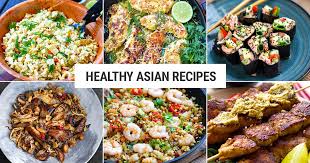In 2024, the global culinary landscape continues to embrace diverse and health-conscious eating habits, and Asian cuisine stands out as a prominent choice for those seeking balanced, nutritious meals. Rich in flavor and variety, Asian recipes offer a wealth of healthy ingredients and cooking techniques that can support a balanced diet. This article explores some of the best healthy Asian recipes for 2024, focusing on their nutritional benefits, preparation tips, and how they fit into a balanced diet.
The Appeal of Asian Cuisine
Asian cuisine encompasses a broad spectrum of culinary traditions, from Japanese and Chinese to Korean, Thai, and Vietnamese. What makes Asian food particularly appealing for a balanced diet is its emphasis on fresh ingredients, balanced flavors, and healthy cooking methods. Many Asian dishes incorporate a variety of vegetables, lean proteins, whole grains, and healthy fats, making them ideal for maintaining overall health and wellness.
Key Components of a Balanced Asian Diet
Before diving into specific recipes, it’s important to understand the key components that make Asian cuisine a great fit for a balanced diet:
- Vegetables: Asian dishes often feature a diverse array of vegetables, providing essential vitamins, minerals, and fiber. Vegetables such as bok choy, broccoli, bell peppers, and carrots are commonly used.
- Lean Proteins: Options like chicken, tofu, fish, and legumes are staples in many Asian recipes. These proteins are generally lower in fat compared to red meats and provide essential amino acids for muscle repair and overall health.
- Whole Grains: Many Asian dishes include whole grains like brown rice, quinoa, or whole wheat noodles, which are rich in fiber and help maintain steady blood sugar levels.
- Healthy Fats: Asian cuisine uses healthy fats from sources like nuts, seeds, and oils (such as sesame oil), which are beneficial for heart health and overall well-being.
- Herbs and Spices: Fresh herbs like cilantro, basil, and mint, as well as spices such as ginger, garlic, and turmeric, are used to enhance flavor without added calories or sodium.
Healthy Asian Recipes for 2024

1. Vietnamese Pho
Pho is a traditional Vietnamese soup known for its aromatic broth and fresh ingredients. It typically consists of a clear broth, rice noodles, herbs, and lean proteins. To make a healthier version:
- Ingredients: Chicken breast, rice noodles, low-sodium chicken broth, ginger, garlic, onions, star anise, cinnamon, cloves, bean sprouts, basil, cilantro, lime.
- Preparation: Simmer chicken breast in a pot with ginger, garlic, and spices. Strain the broth, add the noodles, and serve with fresh herbs and bean sprouts. Use low-sodium broth to keep the sodium content in check.
Nutritional Benefits: Pho is rich in protein from chicken and provides essential vitamins and minerals from herbs and vegetables.
2. Korean Bibimbap
Bibimbap is a Korean mixed rice dish that features a variety of vegetables, proteins, and a spicy sauce. For a balanced version:
- Ingredients: Brown rice, spinach, carrots, mushrooms, zucchini, lean beef or tofu, eggs, sesame oil, soy sauce, gochujang (Korean chili paste).
- Preparation: Cook brown rice and prepare vegetables by sautéing or steaming. Cook the protein of choice and assemble the dish with a fried egg on top. Serve with a small amount of gochujang and sesame oil.
Nutritional Benefits: Bibimbap offers a balanced mix of protein, fiber, and healthy fats. The variety of vegetables provides essential nutrients and antioxidants.
3. Japanese Miso Soup with Tofu
Miso soup is a staple in Japanese cuisine and is known for its umami flavor. It’s also a great source of probiotics and is low in calories:
- Ingredients: Miso paste, tofu, seaweed, green onions, mushrooms, low-sodium vegetable broth.
- Preparation: Heat the broth and dissolve miso paste into it. Add tofu, mushrooms, and seaweed, and simmer until heated through. Garnish with green onions.
Nutritional Benefits: Miso soup is rich in protein from tofu and offers beneficial probiotics from miso paste, which support digestive health.
4. Thai Green Curry with Vegetables
Thai green curry is known for its rich, aromatic flavors and can be made healthier by focusing on vegetables and lean proteins:
- Ingredients: Green curry paste, coconut milk (light), mixed vegetables (bell peppers, eggplant, bamboo shoots), chicken or tofu, basil, lime leaves.
- Preparation: Sauté green curry paste in a pan, add coconut milk and bring to a simmer. Add vegetables and protein, and cook until tender. Finish with fresh basil and lime leaves.
Nutritional Benefits: Thai green curry provides a good balance of protein, healthy fats from coconut milk, and vitamins from vegetables.
5. Chinese Chicken and Broccoli Stir-Fry
Chicken and broccoli stir-fry is a popular dish that can be made healthier by using less oil and incorporating more vegetables:
- Ingredients: Chicken breast, broccoli, bell peppers, carrots, garlic, ginger, soy sauce (low sodium), sesame oil.
- Preparation: Stir-fry chicken with garlic and ginger in a small amount of sesame oil. Add vegetables and cook until tender. Season with low-sodium soy sauce.
Nutritional Benefits: This dish is high in protein and fiber, and using minimal oil helps keep the calorie count low.
Tips for Incorporating Asian Recipes into Your Diet
- Opt for Fresh Ingredients: Use fresh vegetables and herbs to maximize nutritional benefits and flavor.
- Control Portion Sizes: Be mindful of portion sizes, especially when using ingredients like rice and noodles, to maintain a balanced diet.
- Limit Added Sugars and Sodium: Use low-sodium soy sauce and reduce the amount of added sugars in sauces and dressings.
- Experiment with Substitutes: Substitute healthier ingredients, such as brown rice instead of white rice or tofu instead of higher-fat meats, to enhance the nutritional profile of your dishes.
- Balance Your Plate: Ensure your meals include a variety of food groups, such as lean proteins, vegetables, whole grains, and healthy fats.
Conclusion
In 2024, embracing healthy Asian recipes offers a delicious and nutritious way to maintain a balanced diet. By incorporating fresh ingredients, lean proteins, and healthy fats, you can enjoy flavorful dishes that support overall health and well-being. Whether you’re savoring a bowl of Vietnamese pho, Korean bibimbap, or Japanese miso soup, these recipes provide a diverse range of options for a balanced and satisfying diet. As you explore these healthy Asian recipes, you’ll discover new ways to nourish your body while enjoying the rich culinary traditions of Asia.



